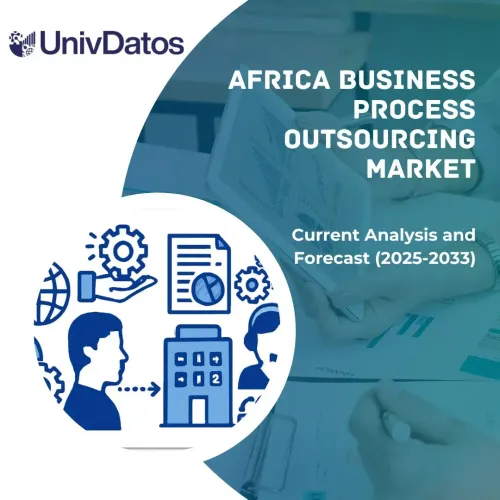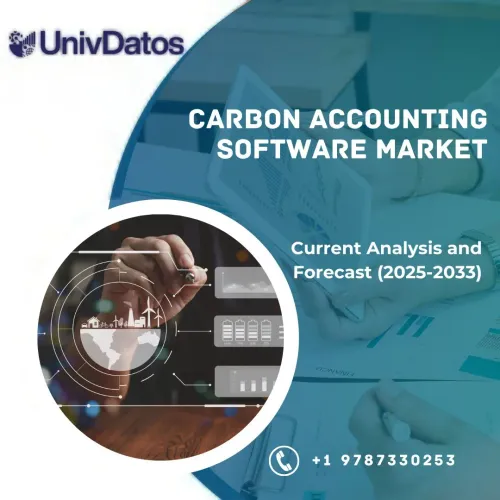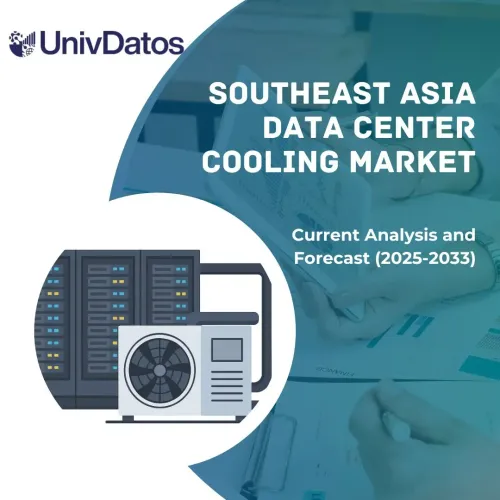- Strona główna
- O nas
- Branża
- Usługi
- Czytanie
- Kontakt
Rynek rolnictwa wertykalnego: analiza bieżąca i prognoza (2022-2028)
Nacisk na Metodę (Hydroponika, Aeroponika i Akwaponika); Struktura (oparte na kontenerach transportowych i oparte na budynkach); Komponent (Nawadnianie, Oświetlenie, Kontrola Klimatu, Kontrola Budynku i Inne) oraz Region/Kraj
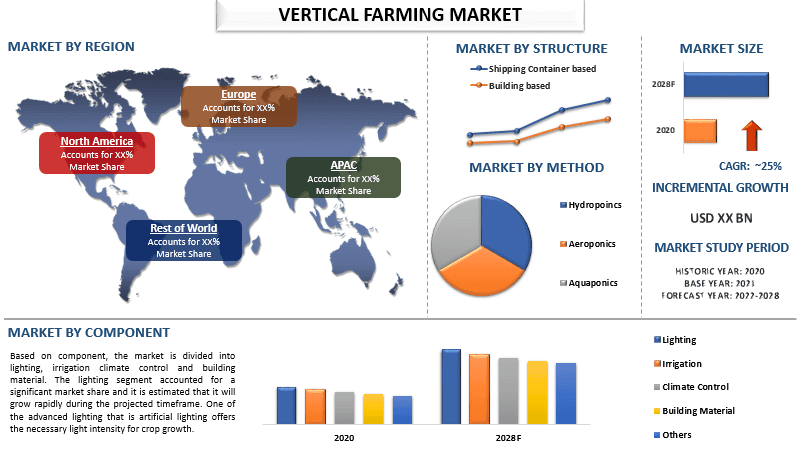
Oczekuje się, że rynek upraw wertykalnych odnotuje CAGR na poziomie ok. 25% w okresie 2022-2028. Uprawy wertykalne — zwane również uprawami wewnętrznymi lub uprawami miejskimi — to proces uprawy żywności w pionowych warstwach, zazwyczaj w strukturach takich jak kontenery transportowe, drapacze chmur i używane magazyny. Uważa się, że żywność ekologiczna jest zdrowsza, bezpieczniejsza i korzystniejsza dla środowiska. Rozwój upraw wertykalnych zależy od rosnącego globalnego popytu na żywność i szybkiego wzrostu urbanizacji. Jednak uprawy wertykalne wymagają sprzętu, co zwiększa początkowy koszt założenia systemu, a także brakuje świadomości na temat technologii stosowanych w alternatywnych praktykach rolniczych, takich jak uprawy wertykalne. Uczestnicy rynku stosują zarówno organiczne, jak i nieorganiczne strategie wzrostu, aby utrzymać przewagę konkurencyjną. Na przykład w październiku 2022 r. Aerofarms ogłosiła swój plan dalszej ekspansji na Bliskim Wschodzie we współpracy z QFZA i Doha Venture Capital (DVC) w celu zbudowania komercyjnej wewnętrznej farmy wertykalnej w Qatar Free Zones (QFZ), która oferuje niezrównaną łączność i dostęp do regionu. Podobnie, w czerwcu 2021 r. firma zajmująca się uprawami wewnętrznymi Bright farms, mając na uwadze rozwój swojego poziomu produkcji, uruchomiła Brightlabs, światowej klasy centrum innowacji i badań w swoim zakładzie produkcyjnym w Ohio. Ponadto uprawy wertykalne, nietradycyjna metoda uprawy roślin, ma znikomy wpływ na klimat, mniejszą powierzchnię sprzętu i mniejsze zużycie wody, dlatego oczekuje się, że rynek będzie rósł ze względu na zwiększony proces adaptacji środowiska.
Do głównych graczy działających na rynku należą: AeroFarms; 4D Bios Inc; Plenty Unlimited Inc; Freight Farms, Inc; Urban Crop Solutions; Sky Greens; Green Sense Farms Holdings Inc; AmHydro; Planet Farms Holdings S.P.A; Koninklijke Philips N.V. to jedni z kluczowych graczy na rynku. Gracze ci podejmują liczne fuzje i przejęcia wraz z partnerstwami, aby ułatwić klientom dostęp do zaawansowanych technologicznie i innowacyjnych produktów/technologii.
Ustalenia przedstawione w raporcie
„Wśród metod segment hydroponiki stanowił znaczący udział w rynku w 2020 r.”
Na podstawie metody rynek jest podzielony na hydroponikę, aeroponikę i akwaponikę. Segment hydroponiki stanowił znaczący udział w rynku i szacuje się, że będzie on szybko rósł w prognozowanym okresie. Rosnący popyt na żywność ekologiczną w połączeniu z rosnącą urbanizacją jeszcze bardziej wspiera udział w rynku w skali globalnej. Na przykład w latach 2000–2030 roczne straty od 1,6 do 3,3 miliona hektarów cennych gruntów rolnych sprzyjały alternatywnym praktykom, takim jak uprawy wertykalne, zgodnie z raportem Konwencji Narodów Zjednoczonych w sprawie zwalczania pustynnienia (UNCCD).
„Oczekuje się, że wśród struktur segment oparty na kontenerach transportowych odnotuje znaczny CAGR w okresie prognozy”
Na podstawie struktury rynek jest podzielony na segment oparty na kontenerach transportowych i segment oparty na budynkach. Segment kontenerów transportowych stanowił znaczący udział w rynku i szacuje się, że będzie on szybko rósł w prognozowanym okresie. Ten wzrost przypisuje się zdolności struktury, niezależnie od lokalizacji, do wspomagania wzrostu upraw. Dodatkowo, wraz ze wzrostem konkurencji, koszty kontenerów transportowych spadają w wyniku stosunkowo niskich kosztów zakupu kontenerów z drugiej ręki.
„Wśród komponentów segment oświetlenia stanowił znaczący udział w rynku w 2020 r.”
Na podstawie komponentu rynek jest podzielony na oświetlenie, nawadnianie, kontrolę klimatu, materiały budowlane i inne. Segment oświetlenia stanowił znaczący udział w rynku i szacuje się, że będzie on szybko rósł w prognozowanym okresie. Jednym z zaawansowanych systemów oświetlenia jest oświetlenie sztuczne, które zapewnia niezbędne natężenie światła do wzrostu upraw.
„Azja i Pacyfik odnotują znaczący wzrost w okresie prognozy”
Azja i Pacyfik stanowią główny rynek dla branży upraw wertykalnych ze względu na główny czynnik, który ma napędzać popyt, jakim jest rosnąca świadomość znaczenia alternatywnego rolnictwa ze względu na malejącą ilość żyznych gruntów rolnych i rosnącą populację w tym regionie. Ponadto oczekuje się, że w regionie Azji i Pacyfiku nastąpi wzrost popytu na żywność ekologiczną.
Powody, dla których warto kupić ten raport:
- Badanie obejmuje analizę wielkości rynku i prognozowania, zatwierdzoną przez uwierzytelnionych kluczowych ekspertów branżowych.
- Raport przedstawia szybki przegląd ogólnej kondycji branży na pierwszy rzut oka.
- Raport obejmuje dogłębną analizę wybitnych konkurentów z branży, z głównym naciskiem na kluczowe dane finansowe przedsiębiorstw, portfolio produktów, strategie ekspansji i najnowsze osiągnięcia.
- Szczegółowe badanie czynników napędzających rynek, ograniczeń, kluczowych trendów i możliwości występujących w branży.
- Badanie kompleksowo obejmuje rynek w różnych segmentach.
- Dogłębna analiza branży na poziomie regionalnym i krajowym.
Opcje personalizacji:
Globalny rynek upraw wertykalnych można dodatkowo dostosować do wymagań lub dowolnego innego segmentu rynku. Oprócz tego UMI rozumie, że możesz mieć własne potrzeby biznesowe, dlatego nie wahaj się z nami skontaktować, aby otrzymać raport, który w pełni odpowiada Twoim wymaganiom.
Spis treści
Metodologia badań rynku upraw wertykalnych (2022-2028)
Analiza historycznego rynku, szacowanie obecnego rynku i prognozowanie przyszłego rynku globalnego rynku upraw wertykalnych to trzy główne kroki podjęte w celu stworzenia i analizy przyjęcia upraw wertykalnych w głównych regionach na całym świecie. Przeprowadzono wyczerpujące wtórne badania w celu zebrania danych historycznych dotyczących rynku i oszacowania obecnej wielkości rynku. Po drugie, aby zweryfikować te spostrzeżenia, wzięto pod uwagę liczne ustalenia i założenia. Ponadto przeprowadzono również wyczerpujące wywiady pierwotne z ekspertami branżowymi w całym łańcuchu wartości globalnego rynku upraw wertykalnych. Po założeniu i zatwierdzeniu danych rynkowych poprzez wywiady pierwotne, zastosowaliśmy podejście odgórne/oddolne do prognozowania całkowitej wielkości rynku. Następnie przyjęto metody podziału rynku i triangulacji danych w celu oszacowania i analizy wielkości rynku segmentów i podsegmentów powiązanych z branżą. Szczegółowa metodologia została wyjaśniona poniżej:
Analiza historycznej wielkości rynku
Krok 1: Dogłębne badanie źródeł wtórnych:
Przeprowadzono szczegółowe badanie wtórne w celu uzyskania danych dotyczących historycznej wielkości rynku upraw wertykalnych poprzez wewnętrzne źródła firmy, takie jak raporty roczne i sprawozdania finansowe, prezentacje wyników, komunikaty prasowe itp., oraz źródła zewnętrzne, w tym czasopisma, wiadomości i artykuły, publikacje rządowe, publikacje konkurencji, raporty sektorowe, bazy danych stron trzecich i inne wiarygodne publikacje.
Krok 2: Segmentacja rynku:
Po uzyskaniu danych dotyczących historycznej wielkości rynku upraw wertykalnych przeprowadziliśmy szczegółową analizę wtórną w celu zebrania historycznych spostrzeżeń i udziałów w rynku dla różnych segmentów i podsegmentów w głównych regionach. Główne segmenty uwzględnione w raporcie to metoda, struktura i komponent. Ponadto przeprowadzono analizy na poziomie krajowym w celu oceny ogólnego przyjęcia modeli testowania w danym regionie.
Krok 3: Analiza czynnikowa:
Po uzyskaniu danych dotyczących historycznej wielkości rynku dla różnych segmentów i podsegmentów przeprowadziliśmy szczegółową analizę czynnikową w celu oszacowania obecnej wielkości rynku upraw wertykalnych. Ponadto przeprowadziliśmy analizę czynnikową przy użyciu zmiennych zależnych i niezależnych, takich jak rosnący globalny popyt na żywność i gwałtowny wzrost urbanizacji. Przeprowadzono dokładną analizę scenariuszy popytu i podaży, biorąc pod uwagę najważniejsze partnerstwa, fuzje i przejęcia, rozwój działalności i wprowadzanie produktów na rynek upraw wertykalnych na całym świecie.
Szacunek obecnej wielkości rynku i prognoza
Określenie obecnej wielkości rynku: W oparciu o użyteczne informacje uzyskane z powyższych 3 kroków, doszliśmy do obecnej wielkości rynku, kluczowych graczy na globalnym rynku upraw wertykalnych i udziałów rynkowych segmentów. Wszystkie wymagane udziały procentowe i podziały rynkowe zostały określone przy użyciu wspomnianego powyżej podejścia wtórnego i zostały zweryfikowane poprzez wywiady pierwotne.
Szacowanie i prognozowanie: Do szacowania i prognozowania rynku przypisano wagi różnym czynnikom, w tym czynnikom napędowym i trendom, ograniczeniom i możliwościom dostępnym dla interesariuszy. Po przeanalizowaniu tych czynników zastosowano odpowiednie techniki prognozowania, tj. podejście odgórne/oddolne, aby uzyskać prognozę rynkową na rok 2028 dla różnych segmentów i podsegmentów na głównych rynkach na całym świecie. Metodologia badań przyjęta do oszacowania wielkości rynku obejmuje:
- Wielkość rynku branży, pod względem przychodów (USD) i wskaźnika adopcji upraw wertykalnych na głównych rynkach krajowych
- Wszystkie udziały procentowe, podziały i podziały segmentów rynku i podsegmentów
- Kluczowi gracze na globalnym rynku upraw wertykalnych pod względem oferowanych produktów. Ponadto strategie rozwoju przyjęte przez tych graczy, aby konkurować na szybko rozwijającym się rynku
Walidacja wielkości rynku i udziału
Badania pierwotne: Przeprowadzono dogłębne wywiady z kluczowymi liderami opinii (KOL), w tym z kadrą kierowniczą wyższego szczebla (CXO/wiceprezesi, szef sprzedaży, szef marketingu, szef operacyjny, szef regionalny, szef krajowy itp.) w głównych regionach. Następnie podsumowano wyniki badań pierwotnych i przeprowadzono analizę statystyczną w celu udowodnienia postawionej hipotezy. Dane wejściowe z badań pierwotnych zostały skonsolidowane z wynikami badań wtórnych, przekształcając w ten sposób informacje w praktyczne spostrzeżenia.
Podział uczestników pierwotnych w różnych regionach
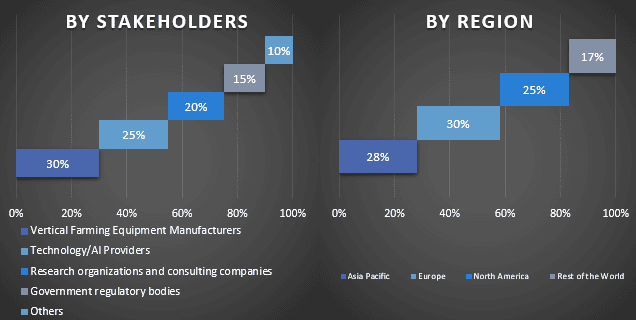
Inżynieria rynku
Zastosowano technikę triangulacji danych, aby ukończyć ogólne szacowanie rynku i uzyskać precyzyjne dane statystyczne dla każdego segmentu i podsegmentu globalnego rynku upraw wertykalnych. Dane zostały podzielone na kilka segmentów i podsegmentów po przestudiowaniu różnych parametrów i trendów w obszarach metody, struktury i komponentu na globalnym rynku upraw wertykalnych.
Główny cel badania globalnego rynku upraw wertykalnych
W badaniu wskazano obecne i przyszłe trendy rynkowe globalnego rynku upraw wertykalnych. Inwestorzy mogą uzyskać strategiczne informacje, na których mogą oprzeć swoje decyzje dotyczące inwestycji na podstawie analizy jakościowej i ilościowej przeprowadzonej w badaniu. Obecne i przyszłe trendy rynkowe określiły ogólną atrakcyjność rynku na poziomie regionalnym, zapewniając platformę dla uczestników przemysłowych do wykorzystania niewykorzystanego rynku w celu skorzystania z przewagi pioniera. Inne cele ilościowe badań obejmują:
- Analizę obecnej i prognozowanej wielkości rynku upraw wertykalnych pod względem wartości (USD). Ponadto analizę obecnej i prognozowanej wielkości rynku dla różnych segmentów i podsegmentów
- Segmenty w badaniu obejmują obszary metody, struktury i komponentu
- Definicję i analizę ram regulacyjnych dla branży upraw wertykalnych
- Analizę łańcucha wartości związanego z obecnością różnych pośredników, wraz z analizą zachowań klientów i konkurencji w branży
- Analizę obecnej i prognozowanej wielkości rynku upraw wertykalnych dla głównego regionu
- Główne kraje regionów badanych w raporcie obejmują Azję i Pacyfik, Europę, Amerykę Północną i resztę świata
- Profile firm zajmujących się uprawami wertykalnymi i strategie rozwoju przyjęte przez uczestników rynku, aby utrzymać się na szybko rozwijającym się rynku
- Dogłębna analiza branży na poziomie regionalnym
Powiązane Raporty
Klienci, którzy kupili ten przedmiot, kupili również


